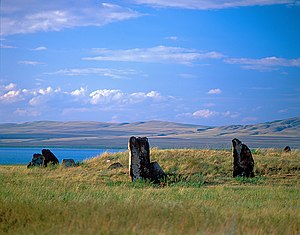Khakassia (Russian: Хака́сия khuh-KAHS-ee-yuh) is a region in Western Siberia, which borders Altai Republic to the southwest, Kemerovo Oblast to the west, Krasnoyarsk Krai to the north and east and Tuva to the southeast.
Cities
[edit]- 1 Abakan — Khakassia's only real "city" and the regional capital
- 2 Abaza — the most important town in southern Khakassia, near the Tuvan border
- 3 Chernogorsk — Second largest population center and location of former gulag
- 4 Sayanogorsk — an extraordinarily polluted aluminum smelting town
- 5 Shira — a village near the salty 1 Lake Shira with historical health spa resort
- 6 Sorsk
Other destinations
[edit]- 2 Khakassky Nature Reserve — stone markers atop ancient burial mounds abound in this steppe reserve
- 3 Chebaki the village of Chebaki with nearby fortress Sve-Takh 4 Chebaki fortress
- 5 Sunduki mountain range — chest-shaped sandstone formations or buttes
- 6 Koshkulak (mountain range) - mountain range with paleogene volcano mountain with variety paleontological fossils of trilobites and nearby Koshkulak cave
- 7 Cherny Iyus - proglacial mountain river
- 8 Bely Iyus - river
Understand
[edit]

Khakassia is named for the Khakass people who are Turkic and comprise only about 10% of the population. Khakassia is often called Siberia's Archaeological Mecca for its enormous profusion of important archaeological sites. Khakassia is full of monuments to the cultural history bestowed upon the region by the people who have inhabited and traversed its steppes for 30,000 years. Travelers may take interest in the many kurgans (burial mounds), sacred sites, rock drawings, stone obelisks, ruined cities, ruins of forts (as old as 3,000 years), and near ubiquitous menhirs.
Talk
[edit]Everyone understands Russian; while the Khakass minority speaks Khakas, a Turkic language, they are nearly all bilingual.
Get in
[edit]You can get to Abakan by rail from the junction at Taishet (Irkutsk Oblast), which is located on the Trans-Siberian Railway.
Abakan's small airport is serviced by domestic flights to/from Moscow, Yekaterinburg, Norilsk, Novosibirsk, Vladivostok, and Kyzyl.
Get around
[edit]See
[edit]- The Great Salbyk Kurgan. A grandiose burial mound 7 stories high.
Do
[edit]- Check out the Khakass national holiday "Tum-Payram" (7 days / 6 nights) in late June/early July.
Eat
[edit]Talğan


